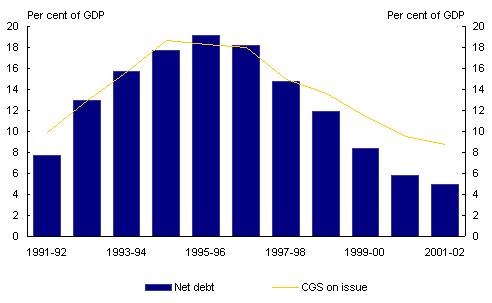A key focus of the Government's economic policy is to ensure Commonwealth finances are sustainable. In accordance with this objective, the Government established the medium-term fiscal strategy of maintaining budget balance, on average, over the economic cycle, and implemented a programme of fiscal consolidation. The Government also undertook a significant programme of asset sales.
These initiatives have produced several years of budget surpluses and significantly reduced Commonwealth general government net debt. As a proportion of gross domestic product (GDP), Commonwealth general government net debt has fallen from a peak of 19.1 per cent in 1995-96 to 5 per cent in 2001-02. A similar reduction in gross debt has accompanied this reduction in net debt. This has been reflected principally in declining Commonwealth Government Securities (CGS) on issue, which fell from around 18 per cent of GDP in 1996-97 to around 9 per cent of GDP in 2001-02 (Chart 1).
[caption id="attachment_40131" align="aligncenter" width="492"] Chart 1: Commonwealth general government net debt[/caption]
Chart 1: Commonwealth general government net debt[/caption]
Reduced net debt has benefited Australia, contributing to lower interest rates and reducing pressure on the current account deficit. As government debt markets have traditionally played an important role in financial markets, reduced net debt has been managed to maintain sufficient depth and liquidity in the CGS market. This involves holding some surplus funds as deposits with the Reserve Bank of Australia rather than repurchasing outstanding debt. Consequently, gross debt is higher than net debt. In addition, the Government has undertaken bond conversion tenders to ensure that CGS outstandings are concentrated in key benchmark securities to increase liquidity at these points in the yield curve.
Notwithstanding these actions, the reduction in Commonwealth general government net debt has lead to a significant fall in the level of gross debt and therefore, CGS on issue. In particular, the amount of Treasury Fixed Coupon Bonds on issue has fallen by around $30 billion since 1996-97. Currently there is around $50 billion on issue.
The reduction in Treasury bonds on issue has caused concern among some market commentators and participants about the continued viability of the CGS market and possible effects on the broader financial market. The Government indicated in the 2002-03 Budget that it recognised these concerns and undertook to examine the issue in consultation with key stakeholders. This discussion paper provides an important framework for consultation, given that all other OECD countries with well-developed financial markets have much higher stocks of government debt than in Australia.
The review will involve close consultation with stakeholders, and to assist this process, a reference committee consisting of representatives from a number of peak industry organisations has been established. This reference committee is intended to provide practical assistance in exploring issues of detail raised in the consultation process.
This discussion paper should assist the process of consulting with stakeholders by outlining the key issues and asking questions intended to assist stakeholders in framing their submissions.
The discussion paper is structured in two parts.
- The first section outlines and assesses possible reasons for maintaining
the CGS market. - The second section outlines and assesses several options available to the
Government to address concerns about the CGS market.
The Government invites stakeholders to provide written submissions to the review. These submissions should focus on the key issues raised in the discussion paper and any other issues that stakeholders consider relevant to the topic. Written submissions should respond to questions raised in the paper.
To ensure a transparent and inclusive consultation process, the Government intends to publish written submissions provided to the review, unless contributors request otherwise. Please provide written submissions by 6 December 2002, as a signed hardcopy with an electronic version. You can send your written submissions to:
Commonwealth Debt Management Review
c/- Department of the Treasury
Langton Crescent
PARKES ACT 2600
and
The Government expects to announce the outcome of the review early in 2003.